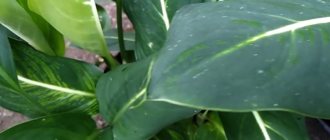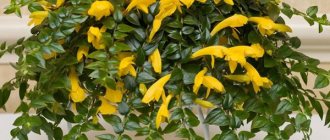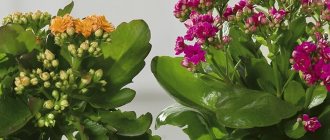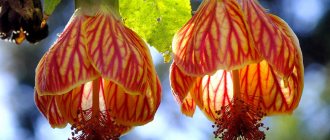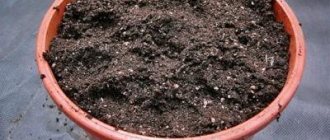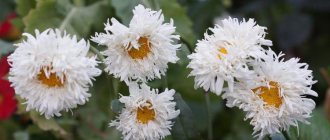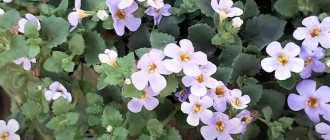Cyclamen is a houseplant belonging to the class of dicotyledons, subfamily Myrsinaceae of the Primrose family. The perennial herbaceous flower is also called alpine violet, and popularly called woody violet. Today there are about 50 varieties. In Russia it grows in the Krasnodar region.
Dear readers! For you, we have created communities on social networks in which useful articles and interesting ideas are published several times a day! Subscribe and receive useful content in a convenient format!
Caring for alpine violet (cyclamen) after purchase
Alpine violets react sharply to changes in habitat. During this period, the flower is a little wilted, the flowers are drooping, but this is a normal phenomenon if the care requirements are followed in the future.
First, inspect the flower. If there are damaged leaves or flower stalks, carefully remove them with garden shears. Within a few days or immediately, cyclamen must be replanted.
Note! If you purchased the plant in a flowering state, postpone replanting until the end of the dormant period.
For the first 3 weeks, place the plant in a secluded place on the bright side so that it does not contract the disease.
Growing conditions
At elevated temperatures during the humid season, the plant prepares for hibernation, so during the heating season, caring for the plant becomes problematic.
The condition of cyclamen depends on 3 indicators. Only by creating ideal conditions in these three points, you will enjoy abundant flowering for 20-30 years.
Temperature
In winter and autumn, the ideal temperature is 10-12 degrees Celsius, and in the summer at rest - from 16 to 20 degrees. Higher or lower rates lead to leaf shedding.
Important! If the alpine violet is grown in a greenhouse environment, create the same conditions at home.
Air humidity
Cyclamen requires high humidity - about 50%. As the plant grows, mist it daily. As soon as the alpine violet begins to bloom, stop this procedure until the plant begins to hibernate.
To increase humidity, it is recommended to create a water mist around the cyclamen, or place an aquarium, a container with water and pebbles nearby.
Lighting
Cyclamen is a light-loving plant, but it does not tolerate the rays of the scorching sun, so the ideal option would be diffused lighting or partial shade.
Choosing a place to put it
The ideal place to grow a flower is a western or eastern window away from radiators. On the sunny side, the sun strongly burns the leaves of the plant, so additional darkening will be required. It's too cold on the north side in winter.
Home care
The main problem with keeping Persian cyclamen at home is providing cool conditions in winter.
temperature during the day is +12…+15°C, at night it can drop to +10°C. In such conditions, flowering will be the longest. An increase in temperature to +20°C can serve as a signal for cyclamen to rest (the plant will “decide” that a hot, dry time is coming). At high temperatures, spider mites are activated, which leads to yellowing of the leaves and often to the death of the plant.
The lighting is bright and diffused. The best location for the plant is on eastern windows. In winter, you can also place it on south-facing windows. With a lack of light, the leaves will begin to turn yellow. When exposed to direct sunlight in spring and summer, burns appear on the leaves.
The air must be clean; cyclamen does not tolerate tobacco smoke and gas fumes, which cause the leaves to turn yellow. Do not place cyclamen in drafts or near heating appliances. At the same time, good air circulation in the room is necessary to avoid rot, so it is not recommended to place plants too closely.
Air humidity is optimal within 50%. To increase air humidity in winter, it is recommended to spray the air from a fine sprayer next to the plant several times a day, without getting on the leaves and flowers. You can place a tray with wet expanded clay next to it. Too dry air can cause damage by spider mites, but with high air humidity (80 - 90%) plants can be attacked by cyclamen mites.
Watering is regular and moderate, preferably from above, without getting on the tuber and leaves. Water for irrigation should be at room temperature. Between waterings, the top layer of soil should dry out, and excess water from the pan should be drained soon after watering. Cyclamen prefers abundant watering after the soil has dried out for some time, but the leaves should not be allowed to lose turgor. Excessive soil moisture can lead to rotting of the roots and tubers, and excessive dryness will cause severe mite damage.
Fertilizing should be done at the time of leaf growth and flowering every two weeks in half doses, adding to the water for irrigation. After purchase, start feeding within a month. The fertilizer should not contain a lot of nitrogen, which leads to leaf growth at the expense of flowering. Plants overfed with nitrogen are more easily susceptible to gray rot.
to clean the leaves ; it is not recommended to use foliage sprays.
|
|
Faded flowers should be removed entirely with the peduncle by turning and tugging, but not too hard, so as not to pull out normal flowers and part of the leaves at the same time. If the attempt fails today, try again tomorrow.
After flowering, seeds are formed, the peduncle is twisted into a spiral and the fruit-box descends to the ground.
What does it look like in the interior?
Cyclamen flowers are drooping and borne on long stalks. After flowering they twist in a spiral. The color of the flower is white, pink, orange and purple.
White flowers in white glossy pots are considered a winning option in the interior.
Mini cyclamens fit well into a minimalist style. In this case, place the flowers in wicker baskets or buckets.
The bright purple or pink tones of cyclamen will fit perfectly into the interior with pine branches, Christmas tree decorations and candles. For them, choose shiny silver or golden pots.
Cyclamens are real stars if you plant them in groups. Select the color depending on the color scheme of the interior.
Do not combine these flowers with other indoor plants - they look advantageous only with their relatives.
3.Varieties:
3.1. Small-flowered cyclamen - Cyclamen parviflorum
A miniature, perennial, evergreen, flowering plant, which, unlike most other cyclamen, does not have a dormant period. The root system of this variety has a slightly flattened, dark purple tuber with a diameter of up to 3 cm. The above-ground part consists of rounded, basal leaves on long, thin petioles. The leaf blades are entire, glossy, dark green, reaching a diameter of 3.5 cm. Sometimes there may be small silvery specks on the leaves. The underside of the leaves can be painted in a contrasting burgundy shade. The flowers are purple or pink, with a very pleasant, delicate aroma, appear in spring.
↑ Up,
3.2. Colchian or Pontic cyclamen - Cyclamen colchicum
Plants with large tubers up to 6.5 cm in diameter. The leaves are dark green, heart-shaped, thick. On the surface of the leaf plates, leaf veins are often highlighted with a silvery tint, and a light border is located around the circumference. The undersides of the leaves are a lighter shade of green. Bright lilac flowers rise high above the leaves on leafless peduncles and have a sweetish aroma.
↑ Up,
3.3. African cyclamen - Cyclamen africanum
Perennial flowering cyclamens with one of the largest tubers - each flower can reach 14 cm in diameter and has a flattened shape. The leaves are heart-shaped, basal, on strong, burgundy petioles, reaching a diameter of 5 - 18 cm, and can appear both before and after flowering. The leaf blades have a finely toothed edge and are often dark green with a striking geometric pattern on the surface. The flowers are delicate, pink, with a pleasant scent reminiscent of violet. Flowering is very abundant.
↑ Up,
Flowering conditions
Alpine violet is divided into 2 types, each of which has its own flowering time:
- Persian drab - from early October to late January.
- European drab - from mid-December to the end of April.
To ensure the plant blooms, maintain the temperature between 10 and 14 degrees Celsius, and also keep it away from the radiator.
Care during flowering
Basic care during flowering consists of the following:
- Do not spray the flower.
- Try to ventilate the room daily.
- Fertilize with fertilizers for flowering plants or mineral complexes once every 2 weeks. Fertilize only according to package directions.
- For abundant flowering, arrange moisture around the pot.
- Do not place near heating devices.
- Water as the soil dries - 3-4 times a week. It is better to infuse the water for 3-4 hours. Its temperature should not be higher than 14 degrees Celsius. The best option is watering through a tray.
- Do not replant plants under any circumstances.
Does a flower need a rest period?
If you follow the rules of care, you can slightly prolong the flowering of alpine violets, but you will not be able to completely get rid of the dormant period. After all, nn is necessary so that cyclamen can rest well and gain nutrients.
Interesting fact! Young cyclamen may not go into hibernation at all and bloom all year round, but over time their regime returns to normal.
The dormant phase of the varieties is as follows:
- In Persian cyclamen, it begins in early spring and lasts until the end of September.
- For Europeans, from summer to late autumn.
External signs of micronutrient deficiency
- The leaves are getting smaller. Nitrogen fertilization is necessary.
- Excess leaves and lack of flower buds indicate excess nitrogen.
- If the cyclamen leaves turn white, it’s time to add potassium.
- Yellowness of the leaves - boron fertilization is required.
- Excess spots on the leaves may be a result of an imbalance of nutrients.
- The uneven appearance of leaves on a flower will indicate a violation of the rules of care: improper watering and insufficient fertilizing.
Features of keeping different varieties
Varieties such as Aneli, Garda, Elbum belong to the European species. They are more hardy and tolerate normal room temperature better. They prefer cool air, so in the summer take them out onto the balcony or garden.
European varieties strongly hate the scorching rays of the sun and tolerate diseases worse. Fertilize plants during flowering no more than once every week and a half.
Varieties of Persian cyclamen, such as mini Aneli, Dark Red, Lila, like humidity from 50% and do not do well if this is not the case. Applying fertilizer costs no less than once every 2 weeks.
Popular varieties
Mini
If you are new to growing cyclamen, we recommend starting with mini cyclamen. It is less demanding to care for than other varieties . More compact. The height of its flowering stems grows up to 10-15 cm. They are ideal for growing indoors, in flowerbeds, in the garden, and on terraces.
Patio
This variety of cyclamen is one of the smallest. Its height is about 10 cm. The flowers are small, brightly colored, from white to carmine. With proper care it blooms from late autumn and all winter.
Transfer
The new pot for replanting should be larger than the previous one and have drainage holes. You can buy soil for replanting or prepare it yourself according to the following recipe:
- ½ Humus and sand.
- ½ turf or deciduous soil.
The transplant is performed in 6 stages:
- Cyclamen is removed from the container along with the soil.
- The root is shaken off and washed under cool water.
- Inspect for damage, rot and mold on the tuber. If there are damaged areas, they are cut off and the cut areas are sprinkled with crushed coal.
- The finished mixture is poured into the pot 1/3 full.
- Insert the plant and fill it to the edges of the pot.
- Water the soil and spray the leaves.
Transplantation is performed every 4-5 years. The best time is early March.
Homemade fertilizers for cyclamen
Instead of ready-made fertilizer, you can use fertilizer prepared at home. Only those fertilizers that are applied to the soil are suitable.
Wood ash solution
In a liter of water at room temperature, dilute 3 tablespoons of ash. The resulting solution is poured over cyclamen, saturating it with zinc, phosphorus and other elements.
Egg shells
You can crush the eggshells to spread them on the soil in the pot. Calcium will enter the soil slowly and will be well absorbed by the plant. Eggshells are safe and suitable if you need to reduce the acidity of the soil.
Agave juice
The fertilizer is useful for strengthening the immunity of cyclamen. To prepare it, you need to take the lower leaves of aloe, wrap them in plastic and put them in the refrigerator. After a few days, you can squeeze the juice out of the leaves. It is diluted with water; take a teaspoon of juice per 1.5 liters of water. You can fertilize cyclamen with this solution no more than once a month.
Landing
The plant is recommended to be planted in August-September. Plant seeds or cuttings at a distance of 2-3 cm from each other. Make the furrow 1 cm deep.
It is better to prepare the substrate for planting yourself from the following ingredients:
- Leaf soil.
- Peat.
- Coarse sand.
- Humus.
Soil brought from a garden plot requires disinfection. It is placed in the oven or doused with boiling water. Holes are made at the bottom of the planting box to allow excess moisture to escape.
Before planting, a 2-3 cm drainage layer of expanded clay is placed on the bottom of the container.
Reproduction
Cyclamen is grown from seeds, daughter shoots and tuber division.
The first option is more reliable - germination rate is 80%. The seeds are first soaked in the stimulator for 18 hours. Plant in an opaque container with substrate.
In the second case, the daughter shoots are torn off and planted in moist soil. The rosette is covered with a bottle for 2-3 weeks.
Method 3 involves dividing the bulb in half and planting them in the substrate. Planting material is taken out of the ground and dried well. Each divided area should have one bud and roots.
Rejuvenation
Cyclamen is constantly growing. Every year, young leaves appear, and old ones die off. As a result, dry tree-like trunks are formed, which noticeably spoil its appearance. This is where plant rejuvenation is required. Many owners are afraid of this process, but in fact it is simple:
- Grab the stem of the flower with all your strength.
- Unscrew the cyclamen at the base with a sharp movement so that the tuber remains intact.
The hardest part will be the care. Now water the cyclamen very little every day. Place the pot in a cool place with diffused light. After a month, a new shoot will appear on the tuber.
Do you want to buy cyclamen?
Terry varieties of cyclanene
In order for cyclamen to become a long-liver at home, when purchasing, you need to choose the right healthy specimen. Don’t be afraid to be picky, because often a ready-made plant from a store begins to act up and dies. What should you pay attention to first?
- The plant should not be over-watered. If the pot is heavy and water is leaking from the bottom, it is possible that this watering regime is common practice in this store. Excess moisture is detrimental to the tuber. It’s better not to risk it and buy a flower elsewhere.
- The root system must be healthy without soft parts. By lifting the pot with the plant, you can assess its condition. The presence of many elastic white roots protruding from the drainage holes is a good sign.
- The plant should not have yellow, limp or spotted leaves. You should refuse to purchase such copies, even if they are sold at a deep discount. It is unlikely that you will be able to make friends with these cyclamens.
- A healthy cyclamen tuber is hard on all sides. If the plant has a lot of buds and young leaves, this also confirms the viability of the tuber.
Ready-made cyclamens are usually purchased in late autumn or winter, so they are well packaged in the store so that the plants do not die during transportation due to the cold.
In order for the flower to better adapt at home, it needs to be replanted from store-bought soil as soon as possible. If this cannot be done in a short time, then the top of the tuber is freed from the soil and placed in a cool place. During this period, you need to be careful with watering, since store-bought cyclamens are sold in peat and it is easy to make a mistake and water a new flower. But still, you shouldn’t delay replanting a purchased plant.
Watering
Water cyclamen when you see that the top layer of soil is dry. You can check dryness with your finger - simply release it into the ground until the phalanx sinks. For unsure gardeners, a humidity indicator is suitable. The frequency of watering depends on the state in which the cyclamen arrives. The young plant is watered more often. Alpine violet does not require much moisture when dormant.
The water temperature should be no more than room temperature. Preferably 2-3 degrees lower.
To settle, take tap water and stir it into a wide-necked vessel. There is no need to close the vessel. Boiled water is not bad at all, but it will not benefit the plant either. Some experienced gardeners use melt water.
Top dressing
Fertilizers for flowering plants with a complex of all necessary substances are suitable for cyclamen. Fertilize according to the instructions on the package. During dormancy, you should not fertilize the alpine violet. You cannot increase the frequency of feeding, you can only reduce it.
Important! Complex fertilizers already contain all the necessary elements, so they should not be combined with homemade recipes.
Choose fertilizers without nitrogen. It can lead to rotting of the tuber and a decrease in flowering intensity.
Types and varieties of cyclamen flower: photo gallery
Of all the species, of which there are 15-18, only two are grown at home. And these two are divided into different varieties. The differences are in color, terry, size, height. There is also a division according to the last parameter: low-growing cyclamen will grow only up to 15 cm, medium-sized ones stay at around 20 cm, and standard growth will not exceed 30 cm.
The tuber of the plant is poisonous, so when working with it, you need to wear gloves. The tubers are quite large, from 8 to 30 cm.
People who buy flowers prefer long-lasting flowering. Therefore, today many hybrids of different varieties of cyclamen with a very long flowering period have been bred.
Cyclamen persica
The Persian species of this plant is universally loved. The variety of hybrids can capture any imagination.
At first it was a plant that blooms strictly in winter, ending this bright period in early spring. But breeders paid attention to the wishes of cyclamen lovers and developed varieties that bloom in any season. Basically, what we find in apartments is called Persian cyclamen. In northern Italy, these plants bloom beautifully in winter.
The leaves of this species are quite large, about 15 cm, and resemble a heart shape with a light pattern. The height of an adult plant is 28-30 cm.
Persian cyclamens:
European cyclamen
The European variety can be confused with the Persian variety, but they are not at all the same plants. European cyclamen is a child of the Alpine mountains and occupies a decent range there. Hence the cute name “Alpine violet”.
This species has several distinctive features:
- Alpine violet does not lose leaves after flowering, but goes into retirement, maintaining a green cap;
- the Persian species blooms in winter, and the European species in summer;
- the Persian looks more luxurious due to the volume of the buds, while the European beauty has smaller inflorescences;
- the smell of alpine violet is more pronounced;
- European inflorescences are lighter;
- The color of the leaves of the European species is soft purple on the reverse side;
- long peduncles are crowned with spirally twisted five long petals of the inflorescence;
- A pleasant bonus can be considered the formation of daughter bulbs-nodules in the alpine violet, with which it is easier to propagate.
There are several hybrids of the European species that are especially loved by gardeners.
Cyclamen Kos
Kos is a Greek island in the Aegean Sea. In nature, you can find small cyclamen bushes with heart-shaped leaves; the bright colors of the flowers immediately catch the eye.
The color is dark at the base of the leaves, while the rest of the leaves are noticeably lighter. Interestingly, the leaves appear only at the end of the flowering period and remain on the plant throughout the winter dormancy period.
The corm of the Kos variety is velvety to the touch and its roots grow only from the bottom.
The handsome Kos man adorns the Greek island:
Cyclamen ivy or Neapolitan
This variety is found not only in cozy apartments, but also in natural conditions.
- The characteristic color of the flowers is pink, although white-flowered hybrids can be seen in homes. The Neapolitan beauty has a root system located close to the surface.
- You can admire the blooms starting in winter and all spring; in addition, a magical aroma will hover near the bush. Leaves may appear both during and after flowering.
- The presence of small horns on the inflorescences can also be considered a feature of the species.
- The leaves are very reminiscent of ivy, hence the name cyclamen.
Admire the beauty of the numerous ivy hybrids!
Cyclamen Victoria
This variety is classified as a Persian species, although the frequency of flowering is close to its European counterpart. The flowering, which looks like a bunch of climbing butterflies, occurs in late autumn and long winter, which is very different from the variety.
Victoria is attractive due to the original color of the petals and their fringed edges.
The best decoration for a northern window sill
Cyclamen mix
Please note that if you see the mark “mix” on such flowers, this does not indicate a separate variety or hybrid. Most often, under this name you will purchase a representative of any variety of the Persian species.
Diseases and pests
The causative agents of cyclamen disease are fungi and bacteria. The cause of the disease is high humidity, low temperatures, and overwatering. The most common ailments:
- Gray rot is a plaque in the form of mold on the leaves of a flower.
- Wet rot - lethargy, drooping leaves, rotten smell of soil.
- Furiosis - the leaves turn yellow gradually from the top of the plant.
Common pests:
- Scale insects are dark spots on the leaves of the plant.
- Thrips - brown spots, deformation of the entire flower.
- Aphids – leaf dying, rotting.
Sick alpine violets are isolated from the rest immediately.
Floretta - fertilizer for cyclamen
This drug has many advantages. It contains the entire complex of microelements: nitrogen, potassium, magnesium, ammophos, phosphorus. It can be applied once, and then returned to fertilizing after three months. All this time, the flower will be reliably protected, nutrients will gradually flow in, breaking down.
Floretta is completely harmless to people. Fertilizer improves soil quality and helps the plant resist diseases. Cyclamen blooms well after feeding, the buds are bright, the crown becomes dense.
How to resuscitate?
Cyclamen can be saved only in the early stages of the disease. To do this, do the following:
- Treat the plant with fungicides (chemicals to kill fungi and bacteria) according to the instructions.
- Inspect the above-ground part and remove affected tissue.
- Remove the tuber and treat it with a strong solution of potassium permanganate.
- Prepare new soil and replant the plant there.
- Place in a dark place for 3 days, water moderately.
Useful video
Watch a video about fertilizers for cyclamen:
On our portal you will find other tips on growing cyclamen at home. Read about the rules for caring for a flower after purchase and the intricacies of replanting a plant.
Answers to popular questions
Do I need to put the alpine violet in a dark place after flowering?
After flowering, the location of the flower is not changed, watering remains the same. The main important rule is not to fertilize during dormancy.
Does the alpine violet shed its leaves during dormancy?
Many people mistakenly believe that the plant necessarily sheds its leaves during hibernation. This is far from true. It all depends on the variety and conditions in which the cyclamen is grown. Young specimens may not shed leaves at all.
Botanical description and history
CYCLAMEN MIX is a representative of the genus of plants of the Myrsinaceae subfamily of the Primrose family. This variety is a hybrid . It was bred by breeders from Persian and European varieties. It is a perennial herbaceous plant. Growth rate is average.
It is used in folk medicine, as well as in the manufacture of pharmaceutical preparations.
ATTENTION! The tubers are poisonous. Be careful!
Widely used for both indoor and outdoor cultivation.
Cyclamen grows for 10-15 years. Flowering is annual and occurs in winter. It can produce up to 70 flowers per year.
Cyclamen is native to Asian and Mediterranean countries. Cyclamen has always been considered the patron saint of women , being a symbol of motherhood and love. Ancient priests claimed that the plant brings happiness to the house. Cyclamen flowers were used in magical rituals and were used to decorate wedding ceremonies. Cyclamen was also credited with the properties of a love potion.
It was brought to Europe in the 17th century. But because its tubers were fed to pigs, it was nicknamed “pork turnip.” Two centuries later, it began to be grown as a houseplant in England.
